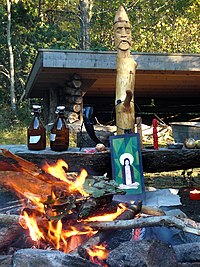
Back Neopaganisme Afrikaans Neopaganismus ALS Neopaganismo AN وثنية جديدة Arabic وثنيه جديده ARZ Neopaganismu AST Çağdaş çoxtanrılıq Azerbaijani Неопаганизъм Bulgarian আধুনিক পৌত্তলিকতা Bengali/Bangla Neopaganisme Catalan

Modern paganism, also known as contemporary paganism[1] and neopaganism,[2] is a type of religion or family of religions influenced by the various historical pre-Christian beliefs of pre-modern peoples in Europe and adjacent areas of North Africa and the Near East. Although they share similarities, contemporary pagan movements are diverse and as a result, they do not share a single set of beliefs, practices, or texts.[3] Scholars of religion often characterise these traditions as new religious movements. Some academics who study the phenomenon treat it as a movement that is divided into different religions while others characterize it as a single religion of which different pagan faiths are denominations.
Adherents rely on pre-Christian, folkloric, and ethnographic sources to a variety of degrees; many of them follow a spirituality that they accept as entirely modern, while others claim to adhere to prehistoric beliefs, or else, they attempt to revive indigenous religions as accurately as possible.[4] Modern pagan movements can be placed on a spectrum. At one end is reconstructionism, which seeks to revive historical pagan religions; examples are Baltic neopaganism, Heathenry (Germanic), Rodnovery (Slavic), and Hellenism (Greek). At the other end are eclectic movements, which blend elements of historical paganism with other religions and philosophies; examples are Wicca, Druidry, and the Goddess movement. Polytheism, animism, and pantheism are common features of pagan theology. Some modern pagans are also atheist. Described as secular paganism or humanistic paganism, this is an outlook which upholds virtues and principles associated with paganism while maintaining a secular worldview. Secular pagans may recognize goddesses/gods as archetypes or useful metaphors for different cycles of life, or reframe magic as a purely psychological practice.
Contemporary paganism has sometimes been associated with the New Age movement, with scholars highlighting their similarities as well as their differences.[5] The academic field of pagan studies began to coalesce in the 1990s, emerging from disparate scholarship in the preceding two decades.
- ^ Doyle White 2016, p. 6.
- ^ Adler 2006, p. xiii.
- ^ Carpenter 1996, p. 40.
- ^ Adler 2006, pp. 3–4
- ^ York 1999.
© MMXXIII Rich X Search. We shall prevail. All rights reserved. Rich X Search